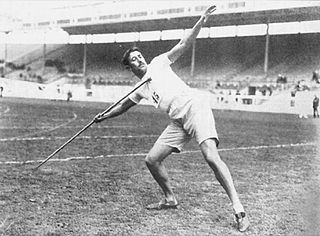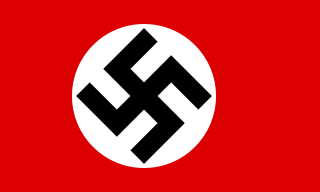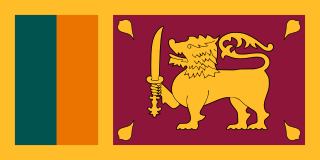
The javelin throw is a track and field event where the javelin, a spear about 2.5 m in length, is thrown as far as possible. The javelin thrower gains momentum by running within a predetermined area. Javelin throwing is an event of both the men's decathlon and the women's heptathlon.

József Várszegi was a Hungarian athlete who competed in the javelin throw. Among his best results are a European Championships bronze medal from 1938 and an Olympic Games bronze from 1948. Várszegi won the Hungarian national championships a record 20 times between 1932 and 1952 and also broke the Hungarian national record six times during his career.

The men's javelin throw was one of six throwing events on the Athletics at the 1908 Summer Olympics programme in London. The javelin was required to be held in the middle. The competition was held on 17 July 1908. 16 throwers from six nations competed. NOCs could enter up to 12 athletes.
The men's freestyle javelin throw was one of six throwing events on the Athletics at the 1908 Summer Olympics programme in London. The javelin could be held anywhere, as opposed to the standard javelin throw which required the javelin to be held by a grip in the middle. This was the only time such a "freestyle" event was held at the Olympics. The competition was held on 15 July 1908. 33 throwers from nine nations competed. NOCs could enter up to 12 athletes.

The Kingdom of Yugoslavia competed at the 1936 Summer Olympics in Berlin, Germany. 93 competitors, 78 men and 15 women, took part in 59 events in 13 sports.

Germany was the host nation and top medal recipient at the 1936 Summer Olympics in Berlin. 433 competitors, 389 men and 44 women, took part in 143 events in 22 sports.

The men's javelin throw was a track and field athletics event held as part of the athletics at the 1912 Summer Olympics programme. It was the second appearance of the event, but in 1908 it was a standing throw with no run up. The competition was held on Saturday, July 6, 1912. Twenty-five javelin throwers from seven nations competed. NOCs could enter up to 12 athletes.
These are the official results of the Men's Javelin Throw event at the 1996 Summer Olympics in Atlanta, Georgia. There were 34 competitors, of which 12 qualified for the final. The qualification mark was set at 83.00 metres.

The men's javelin throw event was part of the track and field athletics programme at the 1920 Summer Olympics. The competition was held on Sunday, August 15, 1920. Twenty-five javelin throwers from twelve nations competed.
These are the official results of the Men's Javelin Throw event at the 1992 Summer Olympics in Barcelona, Spain. There were a total number of 32 participating athletes. The final was held on August 8, 1992, and the qualifying round on August 7, 1992, with the qualification mark set at 80.00 metres.
The men's javelin throw event at the 1988 Summer Olympics in Seoul, South Korea had an entry list of 38 competitors, with two qualifying groups before the final (12) took place on Sunday September 25, 1988. This was the first time that the competitors had to use the new javelin. The qualification mark was set at 79.00 metres.
The Men's Javelin Throw event at the 1984 Summer Olympics in Los Angeles, California, had an entry list of 28 competitors. The final was held on August 5, 1984, and the qualifying round on August 4, 1984, with the qualification mark set at 83.00 metres.
The Men's Javelin Throw at the 2000 Summer Olympics as part of the athletics program was held at the Olympic Stadium on Friday, 22 September and Saturday, 23 September.
The men's javelin throw event was part of the track and field athletics programme at the 1924 Summer Olympics. The competition was held on Sunday, July 6, 1924. 29 javelin throwers from 15 nations competed.
The women's javelin throw event was part of the track and field athletics programme at the 1936 Summer Olympics. The competition was held on August 2, 1936. The final was won by Tilly Fleischer of Germany.

Sri Lanka made its Paralympic Games début at the 1996 Summer Paralympics in Atlanta, with a single athlete in track and field. The country has participated in every subsequent edition of the Summer Paralympics, but has never entered the Winter Paralympics.
The Men's Javelin Throw event at the 1972 Summer Olympics took place on September 2–3 at the Olympic Stadium, Munich. The qualifying standard was 80 m.

The javelin throw at the Summer Olympics is one of four track and field throwing events held at the multi-sport event. The men's javelin throw has been present on the Olympic athletics programme since 1908, being the last of the current throwing events to feature at the Olympics after the shot put, discus throw and hammer throw. The women's event was first contested at the 1932 Olympics, becoming the second women's throws event after the discus in 1928.

Combined events at the Summer Olympics have been contested in several formats at the multi-sport event. There are two combined track and field events in the current Olympic athletics programme: a men's decathlon and a women's heptathlon.

Jayden Sawyer is an Australian para athlete who competes mainly in the F38 category in throwing events. He won has won gold and bronze medals at the World Para Athletics Championships. He competed at the 2016 Rio and 2020 Tokyo Summer Paralympics.











